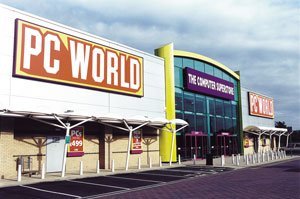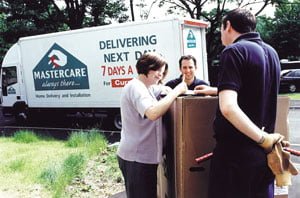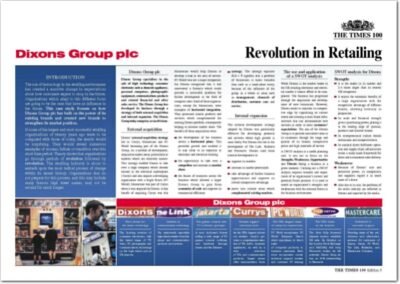
The use of technology in the retailing environment has created a massive change in expectations about how customers expect to shop in the future. Organisations which adapt to this different focus are going to be the ones that have an influence in the future. This case study focuses on how Dixons Group plc has built on the power of its existing brands and created new brands to strengthen its market position.
If some of the largest and most successful retailing organisations of twenty years ago were to be compared with those of today, the results would be surprising. They would reveal numerous examples of success, failure or transition over this short time period. Theory shows that organisations go through periods of evolution followed by revolution. The retailing industry is about to embark upon the most radical process of change within its recent history. Organisations that do not prepare for this process – and this may include many famous high street names – may not be around for much longer.
Dixons Group specialises in the sale of high technology consumer electronics such as domestic appliances, personal computers, photographic equipment, communications products and related financial and after sales service. The Dixons Group has developed its business through a strategy of both external acquisition and internal expansion. The Dixons Group today comprises seven divisions.
Dixons – first choice for the latest technology and the leading retailer of consumer electronics, offering the latest range of TV, video, PC, photographic and communications technology on the high street and at UK airports.
The Link – leaders in communication technology; the nationwide specialist high street retailer of mobile phone and communication products and services.
@jakarta – the games console and PC software specialist. A new, dedicated format selling a wide range of PC games console software and hardware through stores and the Internet.
Currys – Britain’s biggest electrical store. As the UK’s largest electrical retailer, Curry’s provides a comprehensive selection of TVs, hi-fi’s, domestic appliances, as well as a wide selection of PCs and communication products. Larger stores offer demonstration facilities.
PC World – the UK’s largest chain of computer superstores. PC World incorporates PC World Business Direct which specialises in direct sales of computer products to business customers. Each store incorporates on-site technical support centres and customer PC training facilities.
Freeserve – the UK’s home on the Internet. The first fully featured internet service available UK wide. Its flotation on the London Stock Exchange and NASDAQ will help Freeserve realise its full potential. Dixons Group plc has an 80% shareholding in Freeserve.
Mastercare – dedicated to customer support. Providing state of the art, delivery and after-sales services for customers of Dixons, Currys, PC World, The Link, @jakarta, and Mastercare Cover plan.
External acquisition
Dixons’ external acquisition strategy led to Currys, Mastercare and PC World becoming part of the Dixons Group. As a method of development, acquisition makes sense, particularly in markets which are relatively mature. This strategy enabled Dixons to take over a large company which already existed in the electrical marketplace (Currys) and also acquire a developing organisation with a bright future (PC World). Mastercare was part of Currys when it was acquired by Dixons.
A key benefit of acquiring Currys was that Mastercare would help Dixons to develop a lead in the area of service. PC World was not a major competitor, but Dixons recognised that it had uncovered a formula which could provide a successful platform for further development in the field of computer sales. Each of these organisations, except for Mastercare, was an example of horizontal integration.
They possessed similar products and services which complemented the existing Dixons portfolio, consequently helping to increase market share. The benefits of these acquisitions were:
- the development of the business across a horizontal plane. This provided growth and enabled it to stay close to its expertise in electronic and electrical retailing
- the opportunity to take over a competitor and increase its market share
- the fusion of resources across the business which allowed a larger Dixons Group to gain from economies of scale and improve its commercial efficiency
- synergy – the synergy equation 2+2 = 5 signifies that a portfolio of businesses is more valuable than each as a stand-alone entity, because of the influence of the group as a whole in areas such as management, channels of distribution, customer care and service.
Internal expansion
The internal development strategy adopted by Dixons was particularly effective for developing products and services where high growth is most likely. For Dixons this led to the development of The Link, @jakarta and Freeserve. Dixons used these internal developments to:
- segment its markets
- increase its market penetration
- take advantage of further business opportunities and improve its overall competitive advantage
- move into related areas which complemented existing markets.

The aim of the Dixons Group is to provide unrivalled value to its customers through the range and quality of its brands, competitive prices and high standards of service.
A SWOT analysis is a useful planning tool. It sets out to focus on the Strengths, Weaknesses, Opportunities and Threats facing a business at a given moment. Carrying out a SWOT analysis requires research and exploration of an organisation’s current and potential future position. It is used to match an organisation’s strengths and weaknesses with the external forces in the business environment.
SWOT analysis for Dixons
Strengths
Weaknesses
- It is the leader in its market and 2-3 times larger than its nearest UK competitor.
- It enjoys the economic benefits of a large organisation with the competitive advantage of different brands, allowing diversity in proposition.
- Its scale and financial strength gives it purchasing power, placing it at the leading edge of systems, products and discreet brands.
- Its entrepreneurial culture breeds enthusiasm and competitiveness.
- Its national direct fulfilment operation and supply chain infrastructure create a ready made framework for direct and e-commerce sales delivery.
- Because of Dixons’ size and perceived power, its competitors and suppliers regard it as much more of a threat.
- Also due to its size, the problems of the entire industry are reflected in Dixons and reported by the media.
- Its leading position in many of its markets means that its opportunities for further expansion by acquisition within its present sectors are limited.
- Many of its staple product lines have gone from luxury to differentiation in the marketplace.
- Although it buys products internationally, it has no overseas retail outlets.
Opportunities
- The key opportunity for Dixons is the emerging convergence of technologies, such as the Internet, telephony and digital television.
- The Internet has increased opportunities to communicate with customers and to create new channels to market for many of its products. This will help Dixons maintain a competitive edge
Threats
- The Internet is perceived as a potential threat to the traditional retail industry. It has the capacity to reach huge numbers of customers and is a route to the market, which is potentially lower in cost.
- Price deflation in most product categories continues to squeeze margin levels.
- Potential European legislation requiring retail co-operation in the recycling of electrical products could considerably increase Dixons’ costs of sales.
- Potential UK introduction of a digital TV licence and the continuation of analogue broadcasting could restrict the take-up of digital TV.

Different store brands and different methods of retailing have alternative meanings for customers. For example, they might prefer to shop in one supermarket rather than another. They are thus influenced, for a number of complex reasons, by different retail propositions.
The Dixons customer – Impulsive retailing
• Individuals, younger, male, wanting excitement, the latest/newest/smartest.
• Looking for a deal.
• Wanting uniqueness/exclusiveness.
• Instant gratification.
• Individuals and small businesses wanting computers and related products.

The product offer – for the individual
• New technology, latest, newest model/brands, understandable deals, variety from which to choose.
• Strong emphasis on portable (take-away) products.
• Convergence of technologies and products.
• Mobile phones/organisers. Products accessible for mass markets
The Currys customer – Destination retailing
• Families, all ages wanting choice & value.
• Need security that products are good and prices keen.
• Know product they want but not the model.
• To meet a ‘need’ rather than a ‘want’ and the purchase will be planned and will not be instant.
• Require convenience, high quality service and simple methods of payment/delivery.
• Few business customers, some individuals.
The product offer – For the home
• Comprehensive range with keen prices and deals on prices/exclusiveness.
• Dependable names/major brands.
• ‘One stop’ electrical shop.
• Products for the home, often delivered.
• Some products linked to major purchases (i.e. link to kitchens).
The PC World customer – Knowledgeable customers
• Category killer, appealing to all sectors of the market.
• Households, individuals and business customers.
• Some customers seeking choice and value, others seeking technical advice and know-how.
• Desire to see latest/newest but need security by purchasing dependable products with reasonable life cycle upgradeability.
The product offer – Specialist retailer
• Huge choice.
• Expanding categories as technology grows.
• Products with short life cycles and subject to continuous change.
• Brands important.
The Link customer – Communication retailing
• Individuals wanting advice.
• Looking for best price and the right service.
• Small business.
The product offer – Communications for the individual
• New communication products and services.
• Latest and comprehensive range of mobile phones.
• Office communication equipment and organisers.
@jakarta customer – Software retailing
• Individuals looking for information, advice and an enjoyable shopping experience.
• Looking for best price and the latest and popular products which are easy to find in store.
The product offer – Specialist retailer with general appeal
• Wide range of games consoles and computer software products.
• Stores laid out to make products easy to find.
• A separate information desk.
• Brightly lit colourful store to make the shopping experience exciting and enjoyable.
• Retail environment supports

One application of e-commerce is the use of the Internet for business. It is revolutionising businesses because of its speed, reliability and accessibility. Building on the expertise of the Dixons Group in electronic and electrical retailing, the advantages of e-commerce provide an obvious way for the Group to add value to its current proposition and meet changing customer needs.
In 1997, Dixons established both its corporate website and one of the first customer fulfilment websites in this country through which customers could purchase over 1500 lines, on-line. In 1999 Dixons launched PC World and @jakarta sites. Electronic retailing:
- Allows customers to browse through a store’s products to gain information, before they go to the retail outlet to make the purchase
- Allows customers to buy direct from the Internet in the comfort of their own home
- Adds value to the Group’s existing products and services
- Allows the Group to communicate with its customers before its competitors

The Group’s strength has come from its entrepreneurial approach to doing business, as well as its size. It has developed into a non-bureaucratic organisation, which is quick to respond to new ideas. Its group structure offers the potential to operate a business which focuses upon diversified customer needs in a fast-changing marketplace.
E-commerce has placed retailing on the precipice of change and the Group is ideally placed to take advantage of the opportunities that direct marketing and selling over the Internet offers.
 Using promotion to campaign for public services (MP3)
Using promotion to campaign for public services (MP3)  Revolution in retailing (PDF)
Revolution in retailing (PDF) 